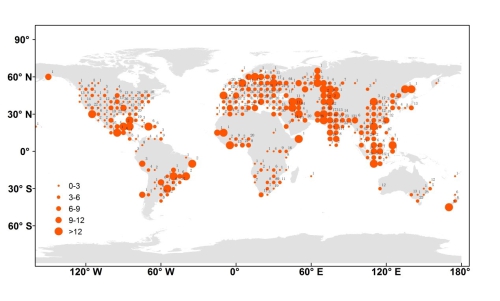Heat stress affects the health of workers and reduces the work productivity by changing the ambient working environment thus leading to economic losses. How to quantify the impact of heat stress on work productivity has remained an issue to the scientific research and policy-making.
In recent years, surveys based on social-science studies have been well applied to quantify the impact of heat stress on the work capacity. However, previous surveys were mainly for developed countries. The number of samples was usually very small (hundreds or even tens) and not suitable for identifying the regional differences across the world. The worldwide pattern of heat-related work productivity loss (WPL) remained unclear.
Recently, YU Shuang, XIA Jiangjiang and YAN Zhongwei from the Institute of Atmospheric Physics, Chinese Academy of Sciences, together with colleagues from China and UK, synthesized 4363 responses to a global online survey in 2016, the most extensive global survey about the effect of heat stress on the WPL currently available, in order to quantify the effects of heat stress on work productivity in different countries for the year.
The survey results show that the heat-related WPL for the year was 6.6 days for developing countries and 3.5 days for developed countries. The heat-related WPL has significant negative correlation with GDP Per Capita (cc=-0.63), indicating that the WPL is inversely proportional to the level of development. They identified the regions of vulnerability to heat waves that might have been overlooked in the past, especially the regions in the Silk Road Economic Belt such as Central Asia and northern Europe due to relatively low adaptability to heat. Heatwave is one of the most serious meteorological disasters in terms of economic loss in the Belt and Road region.

A world-wide pattern of heat-related loss of work productivity (in days) for 2016, based on an online survey with 4043 valid samples. (Image by YU Shuang)
They further estimated the WPL for the future in the Representative Concentration Pathways (RCPs) scenarios( greenhouse gas concentration trajectory adopted by the IPCC and aims to represent the different atmospheric concentration change and climate futures). When global warming reaches 1.5, 2, 3 and 4°C respectively, the average WPL will be 9 (19), 12 (31), 22 (61) and 33 (94) days for developed (developing) countries. Countries in Southeast Asia in a 1.5°C-warming world would suffer the same loss as the developed countries would in a 4°C-warming world. This quantitatively addressed the severe situation that developing countries would face under global warming.
"Heat waves surely impact more seriously the developing countries in general, but our study quantitatively estimated how much heatwaves would reduce the productivity and identified the most vulnerable regions over the world.” YU Shuang said, “Our results call for attention to the need of adaptation to increasing heatwaves by improving protective infrastructure especially for the developing regions in the Belt and Road.”
The paper was published in Journal of Cleaner Production.
Media Contact: Ms. LIN Zheng, jennylin@mail.iap.ac.cn
